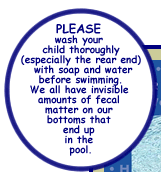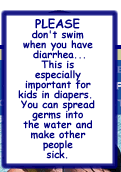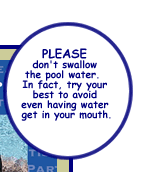But children don't only drown in backyard pools. In-ground spas and inflatable pools can also pose significant dangers. Inside the house, young children are at risk of drowning in bathtubs, large buckets and even toilets.






free online Pool & Spa Safety
Information at https://www.cpsc.gov/cpscpub/pubs/chdrown.html
But children don't only drown in backyard pools. In-ground spas and inflatable pools can also pose significant dangers. Inside the house, young children are at risk of drowning in bathtubs, large buckets and even toilets.
VIGILANCE NEEDED TO PREVENT TRAGEDIES IN THE WATER Below is
a news release on a policy statement published in the August 2007 issue of Pediatrics,
the peer-reviewed, scientific journal of the American Academy of
Pediatrics (AAP). More than 1,400 children and teens under age 20 drowned in 1999, and drowning was the second leading cause of preventable injury death from 1990 to 1999. Many more are injured, often significantly, in near-drowning incidents. The statement spells out the specific risks for each age group, as well as important steps to take to prevent drownings at each age. So for infants and very young children who are most likely to drown around the home, the AAP recommends the following:
Older children are more likely to drown in natural bodies of water and swimming pools. In addition to adequate supervision, recommendations for this age group include:
A new recommendation in the updated statement is for parents to be certain that everyone who will be caring for their child understands the need for constant supervision. They should know about all water-related activities in out-of-home care, and check on child-to-staff ratios (some states require certain ratios for water activities). The statement also suggests actions that pediatricians and communities can take to strengthen laws, regulations and emergency response and reporting systems. These measures can improve future drowning prevention efforts. EDITOR'S NOTE: This policy statement is accompanied by a technical report by the same name that can be found at https://aappolicy.aappublications.org AAP WEBSITE https://www.aap.org EDITOR'S NOTE: The American Academy of Pediatrics is an organization of 57,000 primary care pediatricians, pediatric medical subspecialists and pediatric surgical specialists dedicated to the health, safety and well-being of infants, children, adolescents and young adults.
© 2003 - American Academy of Pediatrics |